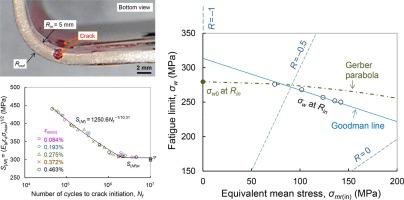International Journal of Fatigue ( IF 6 ) Pub Date : 2020-12-28 , DOI: 10.1016/j.ijfatigue.2020.106125 Gyoko Oh , Yoshiaki Akiniwa

|
There are many thin-walled corners in the components of automobiles, machines, and structures. It is essential to elucidate their fatigue properties and influence factors. Parameters for stress–strain behavior of ferritic stainless plane sheet and pre-strained sheet were obtained under tensile, bending, and cyclic bending loads using the Ramberg–Osgood model. The parameters were integrally used as the fundamental characteristics of bending fatigue behavior for obtaining the mean stress and crack initiation stress amplitude from the measured strains in the curved portion of corner specimens. Bending fatigue tests of pre-strained corner specimens were carried out, and the relationships between the crack initiation strain amplitudes and the mean strains were verified. The strain amplitude ratios of the curved inside to outside portion were analyzed. The residual stress and hardness were measured, and work hardening effect on the inside was higher than that on the outside for improving fatigue strength. The fatigue limit of the corner specimen with the radius ratio of 1.3 was 23% higher than the unworked plane sheet. The effects of mean stress and residual stress on the fatigue strength were analyzed using the fatigue limit–static stress relation equations, indicating that the Gerber parabola can be used for fatigue limit predictions in the stress ratio range of R < –0.5 and that the Goodman line can be used after the point of R = –0.5. The SWT function can be used to accurately predict the fatigue lives in various conditions of stress amplitudes combined with static stresses.
中文翻译:

平均应力和残余应力对不锈钢板预应变角部疲劳行为的影响
汽车,机器和结构的组件中有许多薄壁角。阐明它们的疲劳特性和影响因素至关重要。使用Ramberg–Osgood模型获得了在拉伸,弯曲和循环弯曲载荷下的铁素体不锈钢平板和预应变钢板的应力-应变行为参数。这些参数被整体用作弯曲疲劳行为的基本特征,以便从拐角试样弯曲部分的实测应变中获得平均应力和裂纹萌生应力振幅。进行了预应变拐角试样的弯曲疲劳试验,并验证了裂纹萌生应变幅度与平均应变之间的关系。分析了弯曲的内部与外部的应变振幅比。测量残余应力和硬度,内部的加工硬化效果高于外部,以改善疲劳强度。半径比为1.3的角样的疲劳极限比未加工的平板高23%。使用疲劳极限-静态应力关系方程分析了平均应力和残余应力对疲劳强度的影响,表明Gerber抛物线可用于应力比率范围内的疲劳极限预测。R <–0.5,并且可以在R = –0.5之后使用Goodman线。SWT函数可用于准确预测在各种应力振幅与静态应力相结合的条件下的疲劳寿命。



























 京公网安备 11010802027423号
京公网安备 11010802027423号